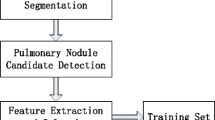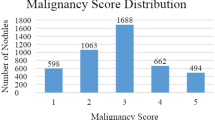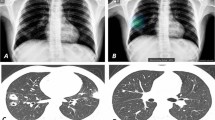Abstract
Purpose
In our previous study, we developed a computer-aided diagnosis (CADx) system using imaging findings annotated by radiologists. The system, however, requires radiologists to input many imaging findings. In order to reduce such an interaction of radiologists, we further developed a CADx system using derived imaging findings based on calculated image features, in which the system only requires few user operations. The purpose of this study is to check whether calculated image features (CFT) or derived imaging findings (DFD) can represent information in imaging findings annotated by radiologists (AFD).
Methods
We calculate 2282 image features and derive 39 imaging findings by using information on a nodule position and its type (solid or ground-glass). These image features are categorized into shape features, texture features and imaging findings-specific features. Each imaging finding is derived based on each corresponding classifier using random forest. To check whether CFT or DFD can represent information in AFD, under an assumption that the accuracies of classifiers are the same if information included in input is the same, we constructed classifiers by using various types of information (CTT, DFD and AFD) and compared accuracies on an inferred diagnosis of a nodule. We employ SVM with RBF kernel as classifier to infer a diagnosis name.
Results
Accuracies of classifiers using DFD, CFT, AFD and CFT \(+\) AFD were 0.613, 0.577, 0.773 and 0.790, respectively. Concordance rates between DFD and AFD of shape findings, texture findings and surrounding findings were 0.644, 0.871 and 0.768, respectively.
Conclusions
The results suggest that CFT and AFD are similar information and CFT represent only a portion of AFD. Particularly, CFT did not contain shape information in AFD. In order to decrease an interaction of radiologists, a development of a method which overcomes these problems is necessary.


Similar content being viewed by others
References
Giger ML, Chan HP, Boone J (2008) Anniversary Paper: history and status of CAD and quantitative image analysis: the role of medical physics and AAPM. Med Phys 35(12):5799–5820. doi:10.1118/1.3013555
Warren Burhenne LJ, Wood SA, D’Orsi CJ, Feig SA, Kopans DB, O’Shaughnessy KF, Sickles EA, Tabar L, Vyborny CJ, Castellino RA (2000) Potential contribution of computer-aided detection to the sensitivity of screening mammography. Radiology 215(2):554–562. doi:10.1148/radiology.215.2.r00ma15554
Shiraishi J, Li F, Doi K (2007) Computer-aided diagnosis for improved detection of lung nodules by use of posterior-anterior and lateral chest radiographs. Acad Radiol 14(1):28–37. doi:10.1016/j.acra.2006.09.057
O’Connor SD, Yao J, Summers RM (2007) Lytic metastases in thoracolumbar spine: computer-aided detection at CT-preliminary study. Radiology 242(3):811–816. doi:10.1148/radiol.2423060260
Fukushima A, Ashizawa K, Yamaguchi T, Matsuyama N, Hayashi H, Kida I, Imafuku Y, Egawa A, Kimura S, Nagaoki K, Honda S, Katsuragawa S, Doi K, Hayashi K (2004) Application of an artificial neural network to high-resolution CT: usefulness in differential diagnosis of diffuse lung disease. AJR Am J Roentgenol 183(2):297–305. doi:10.2214/ajr.183.2.1830297
Burnside ES, Rubin DL, Fine JP, Shachter RD, Sisney GA, Leung WK (2006) Bayesian network to predict breast cancer risk of mammographic microcalcifications and reduce number of benign biopsy results: initial experience. Radiology 240(3):666–673. doi:10.1148/radiol.2403051096
Jesneck JL, Lo JY, Baker JA (2007) Breast mass lesions: computer-aided diagnosis models with mammographic and sonographic descriptors. Radiology 244(2):390–398. doi:10.1148/radiol.2442060712
Shiraishi J, Abe H, Engelmann R, Aoyama M, MacMahon H, Doi K (2003) Computer-aided diagnosis to distinguish benign from malignant solitary pulmonary nodules on radiographs: ROC analysis of radiologists’ performance-initial experience. Radiology 227(2):469–474. doi:10.1148/radiol.2272020498
Chen H, Xu Y, Ma Y, Ma B (2010) Neural network ensemble-based computer-aided diagnosis for differentiation of lung nodules on CT images. Acad Radiol 17(5):595–602. doi:10.1016/j.acra.2009.12.009
Awai K, Murao K, Ozawa A, Nakayama Y, Nakaura T, Liu D, Kawanaka K, Funama Y, Morishita S, Yamashita Y (2006) Pulmonary nodules: estimation of malignancy at thin-section helical CT-effect of computer-aided diagnosis on performance of radiologists. Radiology 239(1):276–284. doi:10.1148/radiol.2383050167
Iwano S, Nakamura T, Kamioka Y, Ikeda M, Ishigaki T (2008) Computeraided differentiation of malignant from benign solitary pulmonary nodules imaged by high-resolution CT. Comput Med Imaging Graph 32(5):416–422. doi:10.1016/j.compmedimag.2008.04.001
Way T, Chan HP, Hadjiiski L, Sahiner B, Chughtai A, Song TK, Poopat C, Stojanovska J, Frank L, Attili A, Bogot N, Cascade PN, Kazerooni EA (2010) Computer-aided diagnosis of lung nodules on CT scans. Acad Radiol 17(3):323–332. doi:10.1016/j.acra.2009.10.016
Kawamoto K, Houlihan CA, Balas EA, Lobach DF (2005) Improving clinical practice using clinical decision support systems: a systematic review of trials to identify features critical to success. BMJ 330:765. doi:10.1136/bmj.38398.500764.8F
Green M, Ekelund U, Edenbrandt L, Bjork J, Forberg JL, Ohlsson M (2009) Exploring new possibilities for case-based explanation of artificial neural network ensembles. Neural Netw 22(1):75–81. doi:10.1016/j.neunet.2008.09.014
Kawagishi M, Aoyama G, Yakami M, Fujimoto K, Kubo T, Sakamoto R, Emoto Y, Iizuka Y, Yamamoto H, Togashi K (2013) A study of automatic inference-model construction with the reasoning disclosure function. In: CARS 2013 Proceedings of the 27th international congress and exhibition. Heidelberg, Germany
Fujimoto K, Yakami M, Kubo T, Sakamoto R, Aoyama G, Togashi K, Iizuka Y, Kawagishi M, Sekiguchi H, Emoto Y, Sakai K, Yamamoto H (2013) Does computer-aided diagnosis system which presents the reasoning for the diagnosis improve radiologists’ diagnostic performance for pulmonary nodules on CT?. In: Proceedings of the 99th annual meeting of the radiological society of North America (RSNA). Chicago, America
Sakamoto R, Fujimoto K, Kawagishi M, Aoyama G, Kubo T, Togashi K, Yakami M, Iizuka Y, Emoto Y, Sekiguchi H, Sakai K, Yamamoto H (2013) Can computer-aided diagnosis (CADx) system that presents reasoning reduce radiologists’ inter-observer variability?: evaluation in interpreting lung nodules on computed tomography. In: Proceedings of the 99th annual meeting of the radiological society of North America (RSNA). Chicago, America
Opulencia P, Channin DS, Raicu DS, Frust JD (2011) Mapping LIDC, RadLex\(^{{\rm TM}}\), and lung nodule image features. J Digit Imaging 24(2):256–270. doi:10.1007/s10278-010-9285-6
Nakagomi K, Shimizu A, Kobatake H, Yakami M, Fujimoto K, Togashi K (2013) Multi-shape graph cuts with neighbor prior constraints and its application to lung segmentation from a chest CT volume. Med Image Anal 17(1):62–77. doi:10.1016/j.media.2012.08.002
Diciotti S, Lombardo S, Coppini G, Grassi L, Falchini M, Mascalchi M (2010) The LoG characteristic scale: a consistent measurement of lung nodule size in CT imaging. IEEE Trans Med Imag 29(2):397–409. doi:10.1109/TMI.2009.2032542
Boykov Y, Jolly MP (2001) Interactive graph cuts for optimal boundary & region segmentation of objects in N-D images. In: Proceedings of International conference on computer vision. doi:10.1109/ICCV.2001.937505
Sekiguchi H, Shimizu A, Fujimoto K, Yakamai M, Sakamoto R, Kubo T, Sakai K, Emoto Y, Togashi K (2012) Segmentation algorithm for GGO nodules from chest CT volumes using boosting and graph cuts. Med Imag Tech 30(4):181–191. doi:10.11409/mit.30.181
Vicente S, Kolmogorov V, Rother C (2008) Graph cut based image segmentation with connectivity priors. In: IEEE computer society conference on computer vision and pattern recognition. Anchorage, America
McNitt-Gray MF, Armato SG 3rd, Meyer CR, Reeves AP, McLennan G, Pais RC, Freymann J, Brown MS, Engelmann RM, Bland PH, Laderach GE, Piker C, Guo J, Towfic Z, Qing DP, Yankelevitz DF, Aberle DR, van Beek EJ, MacMahon H, Kazerooni EA, Croft BY, Clarke LP (2007) The lung image database consortium (LIDC) data collection process for nodule detection and annotation. Acad Radiol 14(12):1464–1474. doi:10.1016/j.acra.2007.07.021
Gierada DS, Pilgram TK, Ford M, Fagerstrom RM, Church TR, Nath H, Garg K, Strollo DC (2008) Lung cancer: interobserver agreement on interpretation of pulmonary findings at low-dose CT screening. Radiology 246(1):265–272. doi:10.1148/radiol.2461062097
Acknowledgements
This work is partly supported by the Innovative Techno-Hub for Integrated Medical Bio-imaging of the Project for Developing Innovation Systems, from the Ministry of Education, Culture, Sports, Science and Technology (MEXT), Japan.
Author information
Authors and Affiliations
Corresponding author
Ethics declarations
Conflict of interest
K. Togashi has received research grants from Bayer AG, DAIICHI SANKYO Group, Eisai Co., Ltd., FUJIFILM Holdings Corporation, Nihon Medi-Physics Co., Ltd., Shimadzu Corporation, Toshiba Corporation and Covidien AG. M. Kawagishi, B. Chen, D. Furukawa, G. Aoyama, Y. Iizuka, K. Nakagomi and H. Yamamoto are Canon Inc. employees. The other authors declare that they have no conflict of interest.
Ethical approval
All procedures performed in studies involving human participants were in accordance with the ethical standards of the institutional research committee and with the 1964 Helsinki Declaration and its later amendments or comparable ethical standards. For this type of study, formal consent is not required.
Informed consent
Informed consent was obtained from all individual participants included in the study.
Rights and permissions
About this article
Cite this article
Kawagishi, M., Chen, B., Furukawa, D. et al. A study of computer-aided diagnosis for pulmonary nodule: comparison between classification accuracies using calculated image features and imaging findings annotated by radiologists. Int J CARS 12, 767–776 (2017). https://doi.org/10.1007/s11548-017-1554-0
Received:
Accepted:
Published:
Issue Date:
DOI: https://doi.org/10.1007/s11548-017-1554-0




